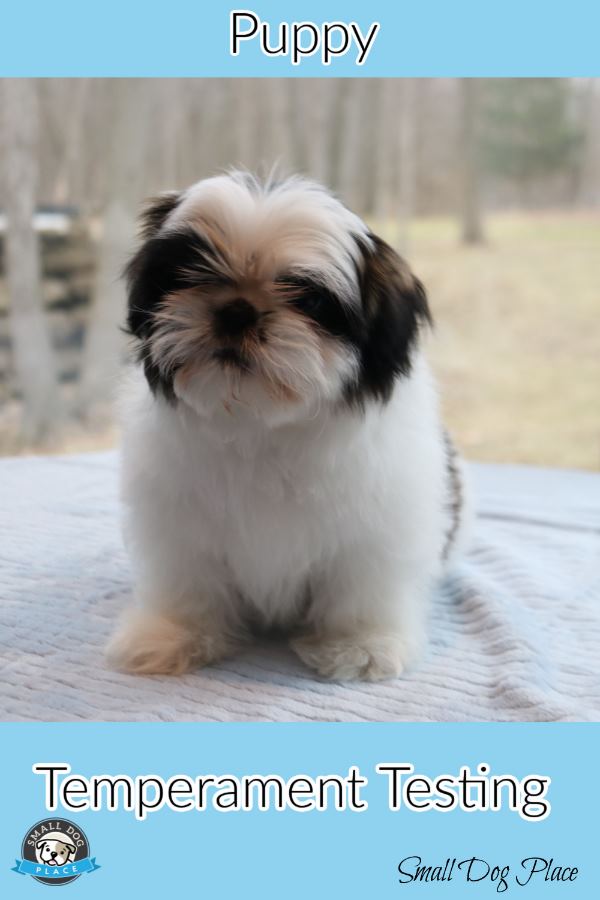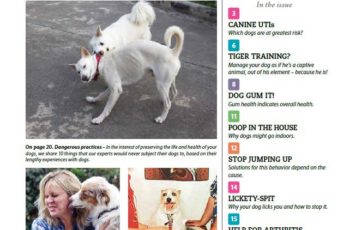by Janice Jones |Last updated 06-17-2021
Puppy Temperament Testing is Part Two
in our series of How to Pick the Perfect Puppy.
You are ready to choose the perfect puppy, but not exactly sure how to
go about it.
Well, this article will
cover behavioral traits and little tests you can do to help determine if the
puppy is right for you.
If you have not read our first article
in this series, picking the Perfect Puppy: Health Issues, we recommend you check it out before proceeding.
I am going to assume that you have:
- Picked the breed of your dreams or are
at least looking at just a couple breeds - Found a breeder you feel you can trust
and work with - Done a little background research on
the breeder and dog breeds - Ready to visit and pick out a puppy
Puppy Temperament Testing Overview
There is no such thing as the universal
perfect puppy. A perfect puppy is
healthy, and his personality fit within your lifestyle and is compatible with
your personality.
Therefore, in other
words, to find your perfect puppy, you must know what you can and cannot live
with in terms of personality traits of dogs.
Dogs and puppies within a specific
breed have similar traits based on their breeding history.
Some for example are more likely to dig
(those dogs that were breed to burrow into holes to search out vermin), chase
(those that were used for hunting small prey), run (breed for hunting and
chasing) bark (guarding) and so forth.
These are all characteristics that are seen in small breed dogs.
Once you have determined the breed of
your choice, the next step is to determine which puppy within the breed will be
the best match for you and your family.
There
is a wide variety even within littermates when it comes to temperament. This is where puppy temperament testing comes into play.

There will be shy and bold puppies, active and
lazy puppies, and those that are smarter or faster. There are those that are more independent and
those that are clingy.
Some dogs love to
be with other dogs, whereas others want only human companionship. Some puppies want to be around other puppies
but most want to be a part of a person’s life.
Anyone who has raised a family knows just how
different each child is even though all the siblings share similar genes. Dogs are no exception.
By the time a puppy is seven weeks old,
you will be able to determine real differences within the litter.
At this point, the puppies may still all look
alike, but their personalities have begun to emerge. This is a good time to look at the litter to
determine which behaviors might be more desirable to your situations.
Decide what is best for you before doing any
formal or casual puppy testing. For
this, you must first look at your own situation:
Puppy Temperament Testing: Ask Yourself these Questions:
Are you:
- A First time puppy owner or lifetime
dog lover with experience in training (Some puppy behaviors might be more difficult
to overcome for a first time buyer. - A person who wants a show potential
puppy? (Some show potential puppies might have
characteristics that would be less desirable in a companion dog. - Someone who wants a puppy just for a
pet or companion - Experienced Dog Owner (There are behaviors that can be corrected with training but may always be
present at some level.)
The Volhard Puppy Aptitude Test (PAT)
is a formal Puppy Temperament Testing System that can be done on puppies at the age of 7 weeks of age.
This is a system of tests, each scored
separately with the purpose to find the right puppy for the right home. It is based on a variety of criteria and
tests certain canine drives such as the prey drive, pack drive, defense fight
or flight drives.
To perform this test,
you would need to have two people present who are unfamiliar to the puppy and
done in an area away from the other litter-mates.
The PAT is observing and puppy temperament testing ten different areas of
behavior:
Social Attraction: How confident the puppy is when interacting
with people
Following: The willingness of a puppy to
follow a person
Restraint: How dominant or submissive a puppy is when
being handled
Social Dominance: The degree a dog will accept a person as the
dominant leader
Elevation Dominance: The degree to which a puppy will submit to a
situation where he is not in control such as at the veterinarian or groomers
Retrieving: The puppy’s willingness to
do something for a person
Touch Sensitivity: The puppy’s degree of sensitivity to a
human’s touch
Sound Sensitivity: The puppy’s degree of sensitivity to sound
Sight Sensitivity: The puppy’s degree of response to a moving
object
Stability: The puppy’s startle response
If you are not interested in formal
testing, you can still look at a variety of behaviors that will give you a good
indication of what the puppy might be like as an adult.
Remember, that ultimately, less desirable
behaviors can be altered by proper training, but even the seemingly “perfect”
puppy needs training and socialization to maintain and improve their behavior.
We have tried to simplify the Volhard
Test so you can use some of the methods when you visit a litter of puppies. If the puppies have just awoken from a nap,
give them some time to awaken fully before coming to any conclusions.
Puppies that just wake up are still a little
groggy. (They are not the only ones). Remember, if you want something more accurate
you will want to use The Volhard Test.)
Steps to follow in Puppy Temperament Testing
Before choosing one puppy to evaluate, watch
all litter mates interact with each other and with you or other people in the
room.
Which ones like to explore on their
own?
Which ones are the first to come to you
or the breeder?
Which ones want to play with their littermates
but do not seem interested in the humans?
Listen to see which puppies yelp the
most when littermates nip them, which ones are quiet?
Which ones seem a little too
aggressive, always wanting to be on top and vying for pack leader
Which puppies seem a little too submissive? Along these same lines, which ones seem to
have the most self-confidence and which ones seem shy.
Which ones seem to crave attention from
humans and stick around for petting?
Which dogs have gentle mouths and which
ones have not learned how to inhibit their bite? Send out a cry when a puppy bites you and
observe his reaction.
Volhard Test: Puppy Temperament Testing
Choose one puppy to evaluate further. The following come directly from the Volhard Test.
Social Attraction
Watch how the puppies interact with you. Which ones come up to you immediately? Which pups are curious, but may not be the first to jump on you? Which ones are more interested in doing something other than coming to you? Observe the tails: are they up or down?
Following
Slowly walk away from the puppies. Which ones follow you? Do they follow with tails up or down?
Restraint
Roll each puppy over on his back and gently
hold for 30 seconds. Do they struggle
fiercely, struggle a little then relax, do not struggle at all.
Social Dominance
Crouch on the floor and gently stroke him from head to tail. Let the puppy sit or lie down while you gentle stroke his back as you crouch down.
Does the puppy jump up at you, bite, or growl, cuddle, roll over, or moved away. See if he licks your face.
Elevation Dominance
Pick up each puppy and hold him or her above your head for 30 seconds. Does the puppy struggle fiercely, or does he struggle but maintain a relaxed body. Perhaps he does not struggle at all but holds onto a rigid body stance.
Retrieving
Crumple up a piece of paper or use a puppy toy if available. Throw it out in front of you no more than 4 feet and observe what the puppy does.
Touch Sensitivity
Pinch the soft webbing on one of the puppy’s front paws, gradually increasing pressure until the puppy shows sign of discomfort. Does the puppy show discomfort immediately or does it take a while before the puppy reacts in pain.
Sound Sensitivity
Clap or bang an object loudly and observe the puppy’s response. Does the puppy listen, try to locate the sound then bark and run towards it?
Alternatively, does the puppy just listen and try to figure where the sound is originating. Some puppies will hide or show no curiosity at all.
Sight Sensitivity
Use a toy or rag and move it around the puppy quickly. Does the puppy run towards it and bite at it? He may try to put his foot on it to stop the motion.
Some pups will look with curiosity with either tail up or down, but not respond and others will run away and hide.
Startle Response
Open an umbrella and place it on the ground. See what the puppy does.
Puppy Temperament Testing: What does it all Mean?
According to Volhard, six different dog
personalities emerge from the responses to these little scenarios using the above criteria for puppy temperament testing:
Pack Leader and Potential to Aggression
Self-Confident Pack Leader
“wantabe”: Need for the Potential Show Dog
Quick Learner, active, social, but
quite a handful
Perfect Puppy, easy to train, quiet,
great for elderly couples, first time dog owners and families with children
Potentially Shy, fearful, submissive
Independent
Most
first time dog owners should choose a dog that learns quickly, is easy to train
and sociable.
Experienced
owners will find self-confidence plus and shy dogs a challenge but not
necessarily out of the question.
Potential
show dog owners will want a pack leader or pack leader want-a-be because they have the self-confidence to do
well in the show ring.
Volhard
recommends that one stray away from the independent type of dog.
Are
all personalities represented in a litter:
No. Not in my opinion, but that
also depends on the breed. You are most
likely to see mostly two, three, four, and five.
Briefly,
according to Volhard, the perfect puppy for the first time buyer using their puppy temperament testing model looks something
like this:
- They
come up to you readily with tail up - They
follow you with their tail up - They
struggle a little when restrained then settle - They
cuddle up to you and try to lick your face - They
enjoy a game of retrieving an object - They
do not cry immediately when pinched but do feel it within about 5 to 6 seconds. - They
show curiosity about sounds and try to find where they originate - They
show curiosity to new sights and try to investigate
Your Take Away from Puppy Temperament Testing
Remember, it takes both your heart and
your head to choose the right puppy for you.
Do not be swayed only by one or the other.
Remember too, that nothing here is
written in stone. Puppies that might be
somewhat shy at the breeder’s house turn out to be outgoing and friendly when
they become part of a loving family. Active
pups may settle down.
Assertive pups
with your loving touch and training turn out to be the perfect dog for
you. Independent dogs may be perfect for
those who need a little personal space.
Finally, the perfect puppy can only
grow into the perfect adult dog with the right socialization and training. Likewise, a less than perfect puppy can
become the perfect adult with the same attention to training.
 Pin for Future Reference
Pin for Future ReferenceDoes This Article Deserve Your Thumbs Up?
We always appreciate your support and encouragement. Your thumbs up means so much to us. Please like this article.
If you find this page or any page on Small Dog Place Helpful, or Useful in anyway, I’d love it if you would click the small heart found on the bottom right of each page.
You can also share or bookmark this page — just click on the:

Free Monthly Newsletter
Sign Up for Our Free Newsletter and get our Free Gift to You.
my E-book, The Top 10 Mistakes People Make When Choosing a Dog (and how to avoid them)


